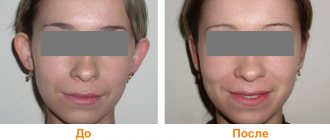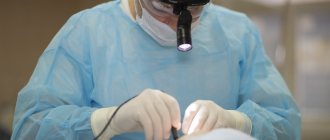- home
- Plastic
- Ear plastic surgery
/
/
Your doctor:
Nichkova Olga Yurievna Certified plastic surgeon. Member of the Society of Plastic Reconstructive Aesthetic Surgeons.
In Yekaterinburg, otoplasty (ear correction) in the aesthetic medicine clinic is performed with high efficiency. The procedure is one of the most frequently performed in professional cosmetology. Otoplasty involves correction of the structure of the auricle, its shape, size, and, in addition, congenital and acquired disorders.
Features and advantages of plastic ear correction
Plastic ear correction helps to get rid of a common cosmetic imperfection – protruding ears. During otoplasty, it is also possible to simulate the position of the ear cartilage. At the aesthetic medicine clinic in Yekaterinburg, ear correction is performed under local anesthesia. The duration of the operation is about an hour. The price of ear otoplasty depends on the complexity of the surgical procedure.
Features of otoplasty for a child from 5 to 14 years old - MEDSI
Table of contents
- At what age can a child have otoplasty?
- Preparing the child
- Indications and contraindications
- Types of ear surgery for children
- How it is carried out: preparation, progress of the operation
- Postoperative period
- Advantages of the procedure at MEDSI
Otoplasty is plastic surgery of the ears, which can be performed for both aesthetic and therapeutic purposes. Otoplasty of the ears of children gives the best results, since it is in childhood that the operation is least painful and most effective.
At what age can a child have otoplasty?
- The most suitable age for surgery is between 5 and 14 years, when the ear cartilage is already sufficiently formed, but retains high plasticity and regenerative abilities
- Children cannot remain completely immobile for a long time, therefore, up to 7 years of age, otoplasty is performed under general anesthesia, but, unlike at an earlier age, the risk of complications of anesthesia in five-year-old children is much lower
- Early ear reshaping eliminates many potential psychological problems in the future.
Preparing the child
For aesthetic otoplasty, children need to obtain their consent and motivate them: many children who refuse plastic surgery out of fear themselves insist on surgery in adolescence.
For reconstructive otoplasty, consent is not required - it is a necessary measure. But even here it is better to persuade and calm the child in order to minimize the stress from the upcoming intervention.
Indications and contraindications
Indications for otoplasty for a child are:
- Congenital anatomical defects (absence of the lobe, underdevelopment of cartilage, hearing impairment associated with cartilaginous deformation)
- Injuries
- Severe protruding ears, asymmetry
Contraindications:
- Acute inflammatory diseases (until complete recovery)
- Oncological processes
- Disturbances in the hemostatic system (blood clotting)
- Diabetes
- Chronic inflammation in the ear and jaw area
Types of ear surgery for children
There are two main types of otoplasty for children
1. Aesthetic
Performed at the insistence of parents. Most often this is the correction of protruding ears or asymmetry of the ears. The advantage of surgery in childhood, in addition to quick recovery, is the psychological aspect. Children socialize more easily if they are not ridiculed at school and do not have complexes due to their appearance in adolescence.
2. Reconstructive
Performed for medical reasons. Modern methods make it possible to completely build up the auricle, or to perform its correction after injuries and deforming diseases. Restoration can be done with local tissues or with the help of implants, and can be unilateral or bilateral. The operation is carried out in 3–4 stages.
How it is carried out: preparation, progress of the operation
Before the procedure you need to undergo examination:
- Pediatrician consultation
- Clinical blood test
- Urine examination
- ECG
If anesthesia is to be performed, the child must:
- Avoid eating 12 hours before surgery
- From taking liquids – 3 hours before
- Avoid certain medications (your doctor will tell you which ones)
For sedation of children, the easiest means are used - the patient quickly comes to his senses. No preparation is required for local anesthesia.
During the operation, incisions are made behind the ear, excess tissue is removed, the ear is pulled back and fixed with medical sutures. Serious defects are corrected with local tissues and implants. The sutures usually dissolve on their own. Thin scars become invisible over time.
Postoperative period
After an hour, the patient can get up and go home. The rehabilitation period lasts 1–2 weeks and consists of wearing a special bandage. For this period, schoolchildren are given an exemption from physical education. Then, for another month, the bandage is worn only at night. All this time you need to protect your ears - avoid injuries, sleep on your back.
Complications - hematomas, infection and suture dehiscence - usually arise when the doctor’s prescriptions are not followed during the rehabilitation period.
Advantages of the procedure at MEDSI
- Opportunity to undergo preoperative examination in the clinic
- Doctors of the highest category, staff trained to receive children
- Availability of consulting specialists and pediatric plastic surgeons who will adequately assess the child’s condition and the need for plastic surgery and select the most gentle intervention technique
- Postoperative appointment to monitor healing and evaluate the effectiveness of the procedure
To make an appointment, call 8 (495) 7-800-500 (open 24 hours a day).
Otoplasty of the ears: progress of the operation
Before direct correction of protruding ears, the plastic surgeon conducts a conversation. The main purpose of the conversation for the specialist is to decide and select the details of the plastic surgery and thereby clarify the price of otoplasty. Correction of the auricle in the clinic is carried out in various ways:
- A portion of the skin is excised from the back of the ear. The surgeon then sews the ear cartilage to the temporal bone to form a tight fit to the head.
- An incision is made behind the auricle to reduce the thickness of the cartilage. Next, sutures are placed on it, which model the shape of the ear and thereby correct the effect of protruding ears.
Due to the high plasticity of the auricle tissue, the operation is successful. The result always corresponds to the stated goal. Otoplasty of all types of ear cartilage is carried out in several stages. The main instrument of a surgeon is traditionally a scalpel. A laser can also be used.
Otoplasty (ear correction)
Professional otoplasty in Yekaterinburg is a specific plastic surgery service, the main goal of which is the correction of the ears. The operation, the quality of which the clinic is proud of, is usually performed under local anesthesia.
The duration of such plastic surgery, which is well tolerated by the patient, is short, from 30 minutes to an hour. The choice of a specific technique that affects the cost of ear correction is individual and depends on the characteristics of anthropometric data (the structure of the outer part of the hearing organ, etc.), as well as the tasks assigned to the surgeon.
For example, correction of protruding ears (so-called “protruding” ears) with a scalpel is carried out in three stages:
- a small dissection of the skin and soft tissues in an invisible surrounding area - the back wall of the auricle;
- dissection of cartilage, excision of its excess volume and change in shape and/or position;
- the formation of a new, aesthetically attractive, auricle, parallel to the head, so that the angle between it and the concha of the ear is 30°.
Ear plastic surgery, which is widespread in the world, consists of more than 150 techniques. They all have their pros and cons. For example, laser ear correction in Yekaterinburg is minimally traumatic and leaves almost no marks, but is more expensive.
At the request of the patient, correction of the auricle can be accompanied by plastic surgery of the earlobe: changing its shape and volume. At the last stage, the surgeon places pads on the operated area and secures them with a bandage/bandage. Its wearing period is equal to a month.
In addition to the most common reason for a patient to seek such correction—congenital or acquired protruding ears—the following factors are also indicated:
- anatomical, congenital imperfections/defects of the auricle;
- reconstructive, for deformities and injuries;
- body modification, when the patient wants to have ear plastic surgery to give them exotic parameters (like an elf, etc.);
- aesthetic, if the patient wishes to artificially change the shape of the ears.
Ear plastic surgery brought to perfection in Yekaterinburg allows the patient to solve all problems.
The final cost of otoplasty in the clinic is also affected by whether one or both ears underwent surgical intervention.
The exact and current price of otoplasty ranges from 5,500 rubles for correcting deformities of one lobe and reaches 89,000 rubles for its main stage. The total cost of the service consists of all manipulations performed by the doctor. Standard of examination before surgery:
- General blood test (valid for 10 days)
- General urine test (valid for 10 days)
- Biochemistry: sugar, protein, bilirubin (valid for 10 days)
- Clotting time (valid for 10 days)
- Duration of bleeding (valid for 10 days)
- Clotting time (good for 10 days)
- Hepatitis B, C (valid for 3 months)
- HIV (valid for 3 months)
- Syphilis (valid for 3 months)
- Blood type (suitable for life)
- ECG (valid month)
- FLG (good for one year)
- Examination by an ophthalmologist (valid for 3 months)
- Examination by a therapist (valid for a month)
Ear care after surgery
At the end of the operation, a protective bandage is applied and the patient is sent home. Those, especially those who have a low pain threshold in their individual symptomatic picture, feel mild pain that quickly passes. To increase comfort, the patient is referred to a consultation with a physiotherapist. Basically, there is sensitivity and slight swelling in the ear area, which goes away after 2 weeks. The bandage must be worn without removing for about three weeks.
Otoplasty - ear surgery
Ear plastic surgery is an operation that helps eliminate aesthetic defects, including protruding ears, starting at the age of 5-6 years. It is at this point that the ears are already formed and correction can be carried out. In childhood, the cartilage of the ears is soft, which greatly simplifies otoplasty and gives a more predictable result. In addition, early operations to eliminate ear defects help avoid the appearance of complexes and psychological trauma.
What types of otoplasty are there?
Most often, otoplasty refers to getting rid of protruding ears. But there are many more types of ear correction. Experts divide otoplasty into two types:
1. Aesthetic - designed to change the appearance of the ears by correcting the size, shape or position of the shell. This type of plastic surgery also includes such a procedure as creating “elf ears”.
2. Reconstructive - allows you to restore the auricle that was lost completely or partially due to injury or other circumstances. For the operation, a transplant is taken from a human rib.
If we talk about possible surgical techniques, then today there are more than 200 of them, each of which differs in the location of the incision and the degree of impact on the ear cartilage and skin tissue. Among the two main methods of surgical intervention are:
- Traditional otoplasty involves the surgeon making incisions using a scalpel.
- Laser otoplasty - incisions are made with a CO2 laser.
The laser method is more common since the risk of deformation of cartilage tissue and possible infection is minimized.
Who should have otoplasty?
The decision on whether to undergo aesthetic ear surgery or not is solely the patient’s desire, because there are no medical indications, because the shape of the ears does not affect the general health and well-being of the patient.
But experts recommend otoplasty for obvious protruding ears, when the angle of deviation of the ear from the head exceeds 30 degrees.
As for reconstructive otoplasty, the indications for the procedure are: complete or partial absence of the auricle.
Otoplasty – what to expect?
Plastic surgery of the ears is performed under local anesthesia in adults and under general anesthesia in children. The choice of technique lies with the surgeon, who is guided not only by the existing shape of the auricle, but also pays attention to the characteristics of the patient’s body.
Aesthetic otoplasty takes from 30 minutes to 2 hours, depending on the original shape of the cartilage. To get rid of protruding ears, an incision will be made at the back of the ear. Through it, the surgeon changes the shape of the cartilage, after which the ears are fixed with sutures and special bandages.
Reconstructive plastic surgery is more complex and is therefore carried out in several stages and takes from 10 to 12 months.
Earlobe plastic surgery
Otoplasty also includes plastic surgery to change the shape or size of the earlobe. It happens that the lobe is pulled back under the influence of large, heavy earrings and looks ugly. Sometimes it is necessary to restore a lobe that has been injured or torn. Lobe plastic surgery is inexpensive and does not cause any difficulties.
What happens to the ears after surgery?
After otoplasty, the incisions do not heal for long and after a week the stitches can be removed. But in order to avoid damaging your ears, you should wear a bandage for 1-2 months that holds them in place and prevents injury.
How the ears have changed will be visible after the bandage is removed, and after three months the final shape will be formed and it will be possible to talk about the results.
You can lead a normal lifestyle within two days after otoplasty, but without extreme sports, which you can do only after six months to avoid injuries.
Are there any contraindications?
Yes, ear diseases, oncology, acute infectious diseases, as well as diabetes and problems with blood clotting are recognized as contraindications to otoplasty.
How to complement otoplasty?
Since otoplasty is the only way to change the shape or size of the ears, there are no alternative options for this operation.
No additional procedures are also required, since otoplasty does not cause hormonal or other changes in the human body. However, to improve the overall aesthetics and after a certain time after otoplasty, injections of Botox or Restylane can be used, and scars behind the ears can be removed through laser resurfacing.










